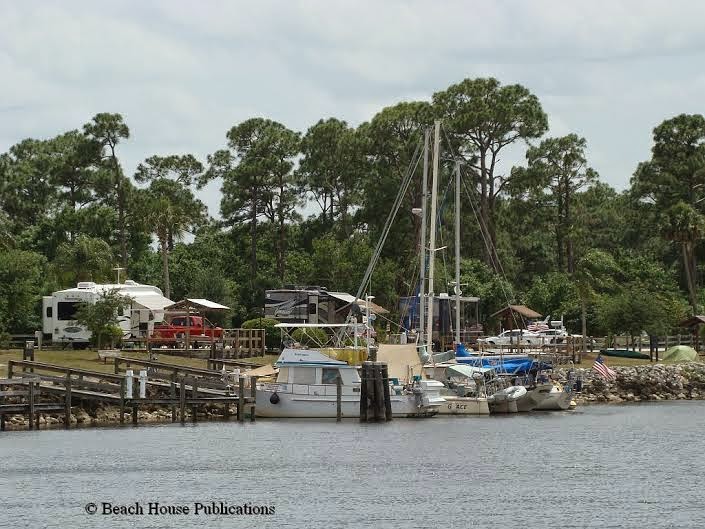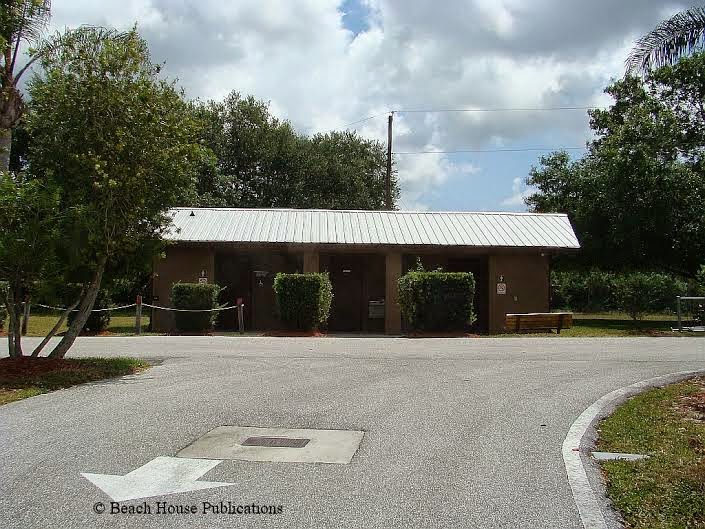St Lucie Lock and Dam Marina and Campground
The St. Lucie Lock and Dam is located a little more than 15 miles upriver from the “crossroads” at the St. Lucie Inlet, the Atlantic Intracoastal Waterway and the St. Lucie River. Approximately 10,000 vessels transit this lock every year and the majority of them are recreational vessels. The Locks are operated from 7 AM to 7 PM, seven days a week. It takes about 20 minutes on average for boats to lock through completely. Signs indicate the arrival point on both sides and the Lockmaster is contacted on VHF Channel 13. He will give instructions to wait for the green light before entering and the Captain can choose the side of the lock on which to tie. Lines are dropped from the lock walls to secure the boat at the bow and stern as the water levels are raised or lowered. The Lockmaster announces when it’s safe to proceed after the lock gates are opened.
Ride along as we transit the St. Lucie Lock.
Immediately after exiting the Lock heading westbound, boaters will see a series of finger piers on their port side with space for eight boats. The finger piers are short, but with some creative tie ups, boats up to 40 feet have used the facilities. The slips are also narrow, making it difficult for two boats with wide beams to tie up in the slip. But if you find the space acceptable, this can be an excellent stopover along the Okeechobee Waterway and an excellent value for transient dockage. Daily fees are $24.00, a flat fee, and include power and water. If you happen to be 62 or over, you are eligible for a Golden Age Passport, allowing you half price entry to any national park, including the St. Lucie Lock and Dam Park. It’s hard to beat $12 per night for dockage that includes power and water! The signs near the docks say that there is a 14 day maximum, but the park has allowed boaters to stay a month or more. Technically there are four slips that can be reserved in advance and four slips on a first-come, first-served basis. The Park Rangers don’t seem to enforce this and at the time we were there, everyone had just arrived and paid the fees with no problem. Some boaters from Stuart make this an annual trek to get away from the hustle and bustle of the town for a while.
The Park is located quite a distance from any kind of shopping or restaurants so without transportation, there is not much to do except rest and relax and maybe get caught up on a few boat projects. As luck would have it, a couple of the boaters there had vehicles and offered rides to anyone that needed one. The campers in the RVs and travel trailers were also a friendly bunch and could be a source for a ride into the shopping centers if needed.
The Park has clean restrooms for the use by the campers and the marina. Each restroom also has a shower. These are cleaned daily by the Park employees and we found everyone very friendly and helpful. A large pavilion with picnic tables, a fire pit and charcoal grills made for an excellent evening get together spot for the boaters and some of the campers. Every afternoon and evening several of us gathered to share drinks, snacks and swap stories. It’s surprising how much the boaters and the campers have in common. We enjoyed the comradery and solitude so much that we decided to stay for a week and take care of some errands. Enterprise Rent-A-Car will pick up and drop off at the Park if a car is needed.
 There are several smaller pavilions around the Park, all with charcoal grills and picnic tables. Walking is our exercise of choice and the Park offers a number of walking trails. There is a walkway across the entire lock and spillway to the other side of the river, where more pavilions and walking trails are available. The view from the lock is pretty incredible - just be sure to be off the gates when they open and close for passing boats. All kinds of wildlife can be found around every corner. Hawks, eagles and osprey soar overhead and the gators lounge in the sun along the banks of the river. You might even find a few snakes along the trail, so be ready for just about anything. A good insect repellent comes in handy for those times when the wind drops off and the little pests come out to feed. At the opposite end of the lock on the same side as the campground is a small visitor center. There are exhibits on the wildlife and history of the lock, and videos with interesting information. The Ranger at the center can answer any questions and they post the Lake levels daily from the Corps of Engineers website. We thoroughly enjoyed our time there and looked forward to getting to the park at the W.P. Franklin Lock on the other side of the Lake and farther across the Okeechobee Waterway. The Park there offers the same services. But that’s a story for another time.
There are several smaller pavilions around the Park, all with charcoal grills and picnic tables. Walking is our exercise of choice and the Park offers a number of walking trails. There is a walkway across the entire lock and spillway to the other side of the river, where more pavilions and walking trails are available. The view from the lock is pretty incredible - just be sure to be off the gates when they open and close for passing boats. All kinds of wildlife can be found around every corner. Hawks, eagles and osprey soar overhead and the gators lounge in the sun along the banks of the river. You might even find a few snakes along the trail, so be ready for just about anything. A good insect repellent comes in handy for those times when the wind drops off and the little pests come out to feed. At the opposite end of the lock on the same side as the campground is a small visitor center. There are exhibits on the wildlife and history of the lock, and videos with interesting information. The Ranger at the center can answer any questions and they post the Lake levels daily from the Corps of Engineers website. We thoroughly enjoyed our time there and looked forward to getting to the park at the W.P. Franklin Lock on the other side of the Lake and farther across the Okeechobee Waterway. The Park there offers the same services. But that’s a story for another time. 




.jpg)











